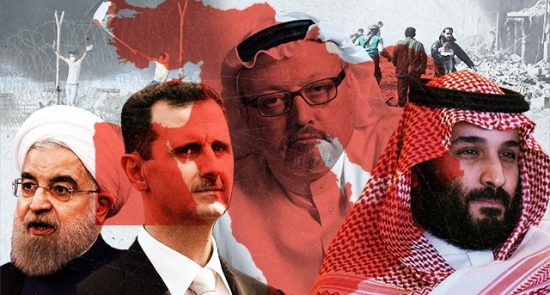Asia December 16, 2018
Short Link:Iran Deal and Saudi Murder; Two Turbulent Events Shook up Middle East in 2018
A murdered Saudi journalist. A scrapped Iran nuclear deal. The two events alone have undone years of diplomacy in the Middle East, testing old alliances and shaking up the regional balance of power, analysts say.
Ariana News Agency- In another turbulent year for the tinderbox region, Syrian leader Bashar al-Assad appeared ever more powerful and Washington’s promised Israeli-Palestinian peace plan seemed ever more elusive.
Meanwhile, Russia -— buoyed by its 2015 intervention in Syria to prop up Assad —- has steadily asserted itself as a key powerbroker in the Middle East, stepping into a diplomatic void left by what observers see as a partial US retreat.
US President Donald Trump, however, has staunchly backed Saudi Crown Prince Mohammed bin Salman, a key regional ally who has faced intense global criticism over journalist Jamal Khashoggi’s murder in Istanbul’s Saudi consulate in October.
Trump has asserted the petro-state’s importance as a lucrative buyer of US arms and a bulwark against common foe Iran, but furious American lawmakers appear in no mood to give the prince a free pass over the murder.
The stakes are high for Trump and the prince, the heir to the Arab world’s most powerful throne who the CIA claims ordered the killing.
Testing US-Saudi ties
“The killing has sparked multiple battles that are likely to shape relationships ranging from that between the US and Saudi Arabia to those between Trump, his Republican Party, the US Congress and the country’s intelligence community,” said James Dorsey, a fellow at Singapore’s S. Rajaratnam School of International Studies.
“The fallout of the killing could also shape Trump’s ability to pursue his policy goals in the Middle East, including forcing Iran to its knees and imposing a settlement of the Israeli-Palestinian conflict.”
The prince -— who sought to project he was no global pariah with an ebullient high-five with Russian President Vladimir Putin at the recent G-20 summit in Argentina —- is expected to weather the crisis.
Pressure on Tehran
A key part of the US strategy is also to ensure that Iran does not emerge as the big winner from the Syrian conflict.
Earlier this year, Trump tore up the Iran nuclear deal -— a result of intense international diplomacy led by European allies and the previous Obama administration — and imposed new sanctions on Tehran that kicked in last month.
“The biggest and most far-reaching change that developed in 2018 was the aggressive American stance towards Iran,” said Hussein Ibish, a scholar at the Arab Gulf States Institute in Washington.
“There is a lot more pressure on Tehran.”
A perceived threat of Iranian expansionism in the Middle East has prompted an undeclared alliance between Israel and several Arab states, observers say.
That was reflected in Prime Minister Benjamin Netanyahu’s surprise visit to the Gulf state of Oman in October, the first by a leader of the Jewish state in 22 years.
He also sought to publicly defend Prince Mohammed following global outrage over Khashoggi’s murder.
Trump, whose administration in May controversially moved the US embassy to Israel to Jerusalem, has promised to deliver a so-called “deal of the century” to resolve the Israeli-Palestinian conflict.
Diplomats and analysts claim the deal, set to be unveiled early in 2019, is secretly backed by several Arab states.
But with public opinion largely pro-Palestinian, many in the Arab world view the warming ties with Israel as a betrayal.
New tensions have also erupted in the Hamas-run Gaza Strip since March 30 when Palestinians launched rolling protests demanding the right to return to homes now inside Israel. Some 235 Palestinians have been killed by Israel soldiers since then. Two Israelis soldiers have died in the clashes.










